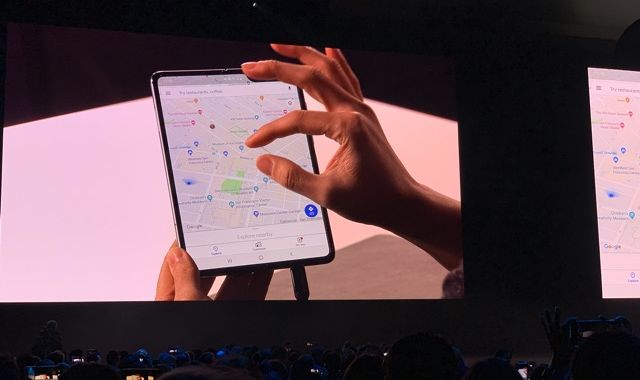https://arstechnica.com/?p=1459689

-
Samsung’s first foldable smartphone, the Galaxy Fold.
Samsung -
Here it is is its folded mode. Those bezels are not tiny!
Samsung -
It’s capable of displaying three apps at once.
Samsung -
It resembles a typical small Android tablet in its unfolded mode.
Samsung -
It also has a fairly decent sized notch in the top-right corner.
Samsung -
It comes in a variety of colors.
After years of teasing, Samsung on Wednesday took the wraps off its first foldable smartphone: the Galaxy Fold.
The device will
start
at a whopping $1,980 and arrive on April 26. Samsung says both LTE and 5G-capable variants will be available. The electronics giant detailed the Android phone-tablet hybrid at an event in San Francisco, where it is also expected to unveil its new flagship Galaxy S10 phones.
As the company hinted at its developers conference last year, the Galaxy Fold consists of two displays: a 4.58-inch, 1960×840 resolution panel that serves as a more traditional smartphone display, and a foldable 7.3-inch, 2152×1536 resolution panel that behaves more like a tablet.
OLED panels are known in part for their flexibility, which in this case allows users to close the Galaxy Fold like a book. Samsung says it uses a hinge system with “multiple interlocking gears” to create the fold, which the company claims is—and indeed appears to be, at first blush—hidden from view. The smaller display sits on the outside of the device for one-handed use. When the phone is fully unfurled, the larger, foldable display can be used like one of Samsung’s Android tablets. This setup differs from other early foldable phone designs like that of the Royole FlexPai, which uses one big bendable outer display.
The Galaxy Fold doesn’t fold completely in half, however, so there is a small gap in the center of the device when it is closed. When it is folded, the smaller screen is surrounded by enormous bezels. The larger display, meanwhile, looks more like a modern tablet, with a noticeably elongated notch in its top right corner. The outer display looks to use a plastic cover—not the traditional, inflexible Gorilla Glass—which should make it relatively prone to scratches, though the design should give the inner display at least some protection from scuffing. Effectively having two devices in one also makes the phone relatively thick, though Samsung has not provided specific dimensions as of this writing.
Samsung is pitching the Galaxy Fold as a “luxury device,” and the details it shared on stage sound appropriately high-end. The company says the Galaxy Fold runs on a “state of the art 7nm processor”—i.e., Qualcomm’s new Snapdragon 855 SoC—and 12GB of RAM. It has a whopping 512GB of UFS 3.0 storage, which should allow it to read data quicker than most other handsets. Powering the multiple displays are a pair of batteries which combine for a 4,300 mAh capacity. Samsung says there are six cameras in the device in total, including three on the back of the device.
Apart from potential durability concerns with a device that’s constantly being opened and closed, one of the big questions here is how well Samsung and Google have optimized Android for the foldable form factor. Google has already said it’s working on this, and on stage Samsung showed off a few software features unique to the Galaxy Fold. The company gave the example of using Google Maps on the smaller display, unfolding the device, and having that map open up in the same spot on the larger display. It also says that the larger display is capable of running three apps simultaneously.
This is a developing story. Samsung’s event is still underway and we will update this post as more information becomes available. For now, you can follow along in real-time with the Ars liveblog.
Listing image by Samsung
via Ars Technica https://arstechnica.com
February 20, 2019 at 01:13PM
